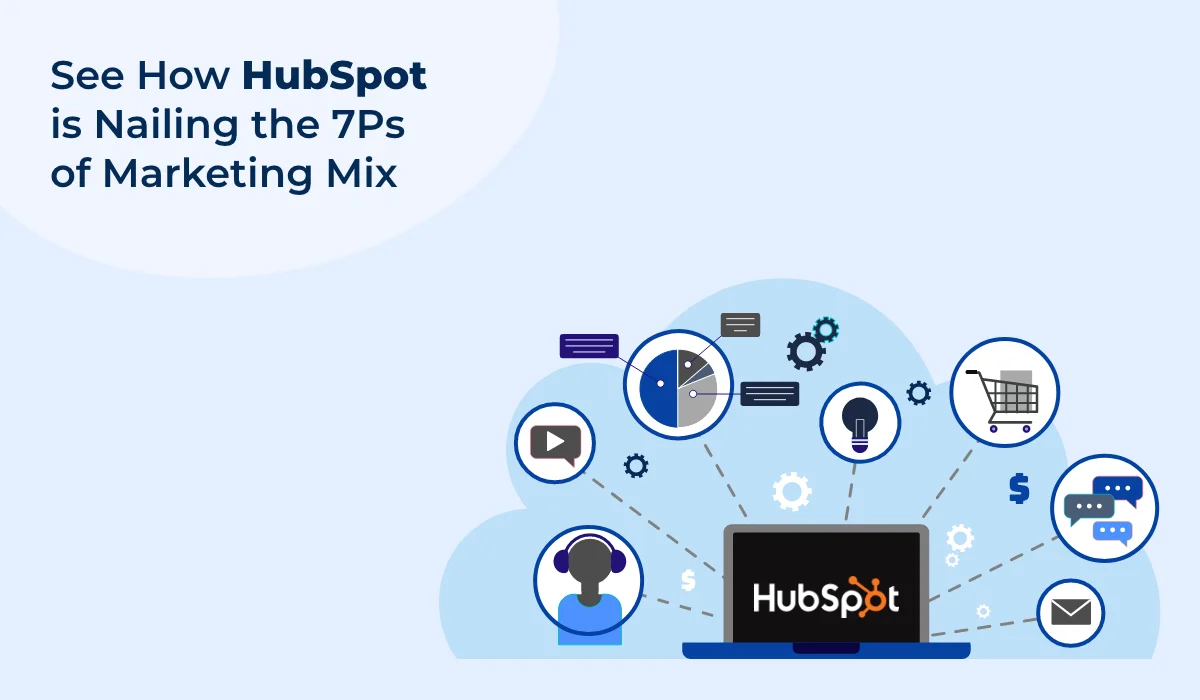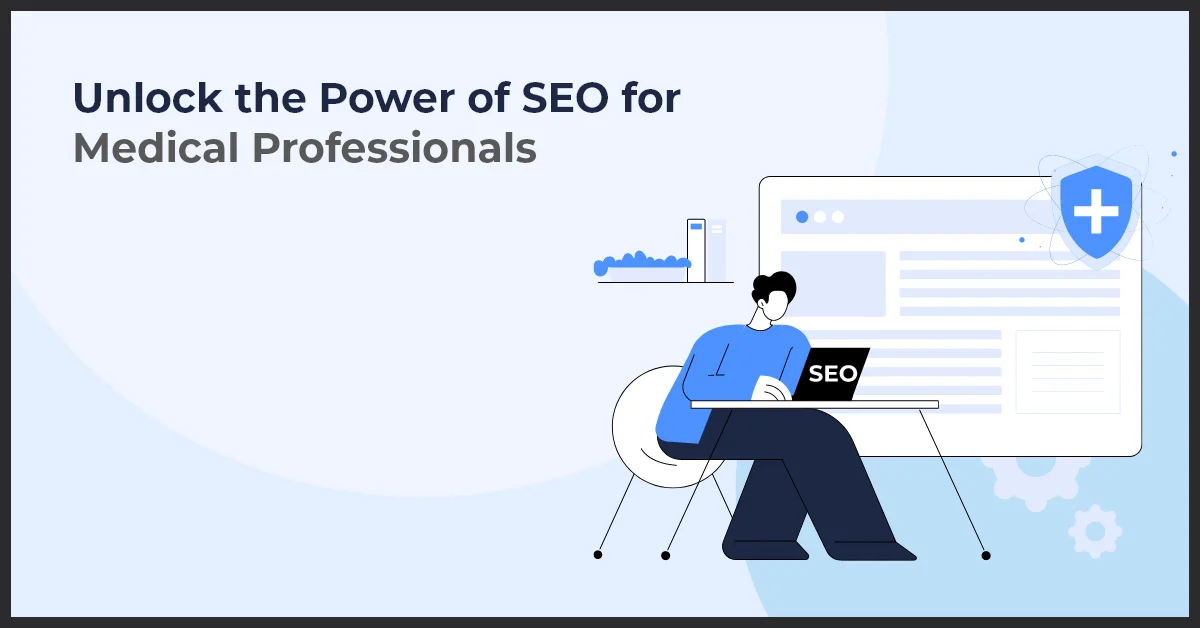Mastering the 7Ps of Marketing Mix: Insights and Strategies Inspired by HubSpot

Published on: February 25, 2021
Updated on: March 07, 2025
3947 Views
- Digital Marketing
15 min read
The Marketing Mix is the key foundation for modern marketing strategies and business activities. It is more of a tool that helps marketers determine a brand’s offering. The Marketing Mix concept was first introduced around the 1960s by Neil H. Borden, where he described business executives as mixers of ingredients. However, it is today a widely accepted fact that Jerome McCarthy founded the concept and gave us the first 4Ps of the Marketing Mix (product, place, price, and promotion).
These 4Ps further paved the way for the modern-day 7Ps of Marketing Mix, the additional three of which were given by Booms and Bitner in 1981. Now, the Marketing Mix not only includes physical things but also products that are services. For you to promote your brand or product effectively, you must know how to create a strategy that concocts the key marketing ingredients together. So why not learn it from a renowned software company that is totally killing it in its unique approach.
Check out the infographic below and see how HubSpot is incorporating the 7Ps of the Marketing Mix to win customers.
Understanding the Marketing Mix
The marketing mix is a concept that plays a crucial role in the success of any business. It consists of seven key elements that collectively form a comprehensive strategy for achieving marketing objectives. By understanding and effectively implementing the marketing mix, businesses can optimize their offerings, pricing, promotion, placement, people, processes, and physical evidence.
Explanation of the Marketing Mix concept
The marketing mix is a framework that helps businesses develop and execute effective marketing strategies. It takes into account various factors that influence consumer behavior and decision-making. By addressing these factors, businesses can create a compelling value proposition that resonates with their target audience.
At its core, the marketing mix comprises four main components: product, price, promotion, and place. These four elements are often referred to as the "4Ps of marketing." However, to provide a more comprehensive strategy, three additional elements have been added to the mix: people, process, and physical evidence. Together, these seven elements create a holistic approach to marketing.
Comprehensive Breakdown of the 7Ps of Marketing Mix
1. Product (P1): This element focuses on the features, benefits, and attributes of a company's offering to meet the needs and wants of the target market. It involves aspects such as quality, design, functionality, and packaging.
2. Price (P2): Price refers to the amount customers are willing to pay for a product or service. It involves determining the right pricing strategy, considering factors like costs, competition, perceived value, and market demand.
3. Promotion (P3): Promotion encompasses all the activities businesses undertake to communicate and promote their products or services to the target audience. It includes advertising, public relations, sales promotions, personal selling, and digital marketing strategies.
4. Place (P4): Place refers to the channels and distribution network through which products or services are made available to customers. It involves strategic decisions related to distribution channels, logistics, warehousing, and inventory management.
5. People (P5): People refers to the employees, staff, and personnel who interact with customers and deliver the service experience. It encompasses aspects like customer service, employee training, and building strong relationships with customers.
6. Process (P6): Process represents the activities, procedures, and systems that businesses use to deliver their products or services. It involves streamlining and optimizing internal processes to ensure efficiency, consistency, and customer satisfaction.
7. Physical Evidence (P7): Physical evidence refers to tangible cues or elements that help customers evaluate the quality and value of a product or service. It includes factors like branding, packaging, store layout, signage, and customer testimonials.
Product (P1):
The Product element is a crucial component of the 7 P's of Marketing mix. It refers to the goods or services that a company offers to its customers. In today's competitive market, it is essential to have a product that stands out and meets the needs and wants of the target audience.
Choosing and designing the right products
Choosing and designing the right products is vital for the success of any marketing strategy. The product should align with the company's brand, values, and customer expectations. It should also be unique and provide value to the customers. By understanding the target audience, their preferences, and market trends, a company can develop products that cater to the needs of the customers effectively.
Factors to consider when developing a product strategy
- Market Demand: Understanding the demand for certain products in the market is crucial. Conduct market research to identify gaps or opportunities that can be filled by your product.
- Competition: Analyze the products offered by competitors and find ways to differentiate your product. Focus on unique selling propositions (USPs) that set your product apart from others.
- Target Audience: Develop a deep understanding of your target audience's demographics, interests, and behaviors. This knowledge will help you design a product that meets their specific needs and wants.
- Product Lifecycle: Consider the lifecycle of your product and plan for future developments or modifications. This ensures that your product remains relevant and competitive in the market.
- Pricing: Determine the pricing strategy for your product. It should be competitive, considering factors such as production costs, profit margins, and perceived value.
- Branding: Create a strong brand identity for your product. Develop a brand message that resonates with your target audience and communicates the value your product brings.
- Distribution: Decide on the distribution channels that will help you reach your target audience effectively. Consider both online and offline channels, depending on your product and target market.
Price (P2):
In the marketing mix, price represents the value of a product or service that a customer is willing to pay. It plays a crucial role in determining the success of a marketing strategy.
There are various pricing strategies that businesses can employ:
- 1. Cost-based pricing: This strategy involves calculating the cost of production and adding a desired profit margin to determine the selling price. It helps businesses cover their expenses and generate profits.
- 2. Competition-based pricing: With this strategy, businesses set the price based on their competitors' pricing. They may choose to set their price lower than the competition to attract customers or higher to convey a sense of exclusivity.
- 3. Value-based pricing: Value-based pricing focuses on the perceived value of a product or service to the customer. It takes into consideration factors such as quality, features, and benefits. Businesses using this strategy aim to capture a premium price for their offerings.
- 4. Psychological pricing: This strategy takes advantage of consumers' psychological tendencies. For example, setting a price just below a round number (e.g., $9.99 instead of $10) creates the perception of a lower price, even though the difference is minimal.
When determining pricing strategies, businesses need to consider several factors:
- 1. Customer demand: Understanding customer demand for the product or service helps to set a price that matches their perceived value and willingness to pay.
- 2. Competitor pricing: Analyzing the pricing strategies of competitors helps to position the product or service in the market effectively.
- 3. Costs and profit objectives: Taking into account production costs, overheads, and desired profit margins ensures that the pricing strategy is financially viable for the business.
- 4. Market conditions: Keeping track of market trends, economic conditions, and industry-specific factors helps to adapt pricing strategies accordingly.
By carefully considering the role of price, implementing appropriate pricing strategies, and taking into account relevant factors, businesses can optimize their marketing efforts and achieve their financial goals.
Promotion (P3):
Promotion is one of the key elements of the marketing mix that focuses on creating awareness and generating interest in a product or service. Its role is to communicate the value proposition of the product and persuade potential customers to make a purchase.
There are various promotional techniques and channels that businesses can utilize to reach their target audience. These include advertising, public relations, sales promotions, direct marketing, and digital marketing. Each technique has its own advantages and can be effective in different scenarios.
Developing an effective promotional campaign requires careful planning and consideration of the target market, message, and budget. The campaign should be tailored to appeal to the needs and preferences of the target audience while aligning with the overall marketing objectives.
Successful promotion not only helps in creating brand awareness but also in building customer loyalty and ultimately driving sales. By effectively communicating the value of the product and its benefits, businesses can connect with their target audience and influence their buying decisions.
Place (P4):
Ensuring your product reaches the right audience
The Place element of the 7Ps of Marketing mix refers to the distribution channels and strategies used to bring your product or service to the market. It's about making your product or service available to the target customers at the right time and place.
Choosing the right distribution channels is crucial for the success of your marketing efforts. It's important to consider factors like the nature of your product, the target market, and the competition. By understanding these factors, you can select the most appropriate channels to reach your customers.
Effective product placement and distribution strategies play a key role in attracting customers and boosting sales. By strategically placing your product in locations where your target audience is likely to see it, you can increase visibility and generate more interest.
Additionally, it's important to establish strong partnerships with distributors and retailers to ensure your product is readily available to customers. This involves developing clear agreements, monitoring performance, and providing support to ensure that your product is effectively distributed.
In summary, the Place element of the marketing mix is essential in getting your product to the right audience. By carefully selecting distribution channels, implementing effective product placement strategies, and building strong partnerships, you can maximize your reach and increase the chances of success for your marketing efforts.
Remember: The success of your marketing efforts greatly depends on how well you handle the Place element of the 7 P's of Marketing.
People (P5):
Definition and role of the People element
In the 7 P's of Marketing, the People element refers to the individuals who are involved in the buying process, including both the customers and the employees. People play a vital role in shaping the success of any marketing strategy as they are the ones who interact with the product or service directly.
The significance of well-trained and motivated employees
Well-trained and motivated employees are crucial for the success of any marketing campaign. They are the face of the company and directly impact the customer's experience. When employees are well-trained, they possess the knowledge and skills necessary to provide excellent customer service, answer queries, and address concerns. Motivated employees are also more likely to go above and beyond to satisfy the customer's needs, resulting in increased customer loyalty and positive word-of-mouth.
Ways to ensure excellent customer service
- Invest in comprehensive training: Provide regular training sessions to employees to enhance their product knowledge, communication skills, and problem-solving abilities.
- Encourage a customer-centric culture: Foster a work environment that prioritizes customer satisfaction by instilling a customer-centric mindset in all employees.
- Reward exceptional performance: Recognize and reward employees who consistently deliver exceptional customer service to motivate them and create a positive work atmosphere.
- Solicit customer feedback: Actively seek feedback from customers to identify areas for improvement and address any issues promptly.
- Empower employees: Give employees the authority to make decisions and resolve customer issues independently, enabling them to provide efficient and personalized service.
Process (P6):
In the world of marketing, the process element plays a crucial role in the overall success of a business. It refers to the activities, systems, and procedures that an organization follows to deliver its products or services to the customers.
The process element encompasses everything from manufacturing to distribution, from order processing to customer support. It ensures that the entire journey of a customer, from discovering the product to making a purchase, is smooth and seamless.
Streamlining and improving business processes is vital for any company. By optimizing the processes, businesses can reduce costs, increase productivity, and ultimately enhance customer satisfaction. It involves analyzing existing processes, identifying bottlenecks, and implementing changes to improve efficiency.
Delivering efficient and customer-friendly processes is of utmost importance. Customers expect a hassle-free experience when interacting with a business, and a well-designed process can make all the difference. It not only ensures customer satisfaction but also builds brand loyalty and positive word-of-mouth.
Physical Evidence (P7):
The Role of Physical Evidence in the Marketing Mix
Physical Evidence is an essential element of the 7Ps of Marketing, emphasizing the tangible aspects of a business's offerings. It refers to the physical cues present in a customer's experience and includes everything from packaging and signage to the appearance of employees and the establishment itself. Physical Evidence plays a crucial role in creating a positive brand image and enhancing customer satisfaction.
Creating a Positive Brand Image through Tangible Elements
Physical Evidence provides customers with visual proof of a company's promises and commitments. It allows them to gauge the quality of a product or service and forms a crucial part of their decision-making process. For example, luxurious and well-designed packaging can give the impression of a premium product, influencing customers to perceive it as high-quality.
Ensuring Consistency Across Physical Touchpoints
Consistency is key when it comes to Physical Evidence. From the appearance and behavior of employees to the layout and ambiance of physical spaces, all touchpoints must align with the brand's message and values. By maintaining a consistent physical experience, businesses can build trust and loyalty among customers.
Integrating the 7Ps of Marketing:
Demonstrating how the 7Ps work together to create cohesive marketing strategies.
Integrating the 7Ps of marketing is essential for creating effective and successful marketing strategies. Each of the 7 P's - product, price, promotion, place, people, process, and physical evidence - plays a crucial role in defining and shaping the overall marketing mix. By integrating these elements, businesses can develop a comprehensive strategy that aligns with their goals and target audience.
When integrating the 7Ps, it's important to consider how each element interacts with and supports the others. For example, the product must be designed and positioned to meet the needs and wants of the target market (Product - P1). The price should reflect the value that the product offers and be competitive in the market (Price - P2). Promotion strategies should be tailored to reach the target audience and effectively communicate the product's benefits (Promotion - P3).
The place where the product is available should be carefully chosen to ensure accessibility and convenience for customers (Place - P4). The people involved in the marketing process, such as sales representatives and customer service personnel, should be trained to provide excellent customer experiences (People - P5). The process of delivering the product or service should be efficient and streamlined to meet customer expectations (Process - P6). Physical evidence, such as packaging or the appearance of storefronts, should reinforce the brand and product quality (Physical Evidence - P7).
A cohesive marketing strategy that takes into account all 7Ps will help businesses create a consistent and compelling brand image, reach their target audience effectively, and drive sales. To better understand the concept of integration, let's explore some case studies and examples of successful implementation.
Conclusion:
Implementing the 7Ps of Marketing is crucial for any business looking to succeed in today's competitive market. By understanding and incorporating each element of the marketing mix, businesses can effectively create and deliver value to their target audience.
The 7Ps of Marketing provide a comprehensive framework for businesses to strategize and execute their marketing efforts. From developing a quality product or service (P1) to determining the right pricing strategy (P2), businesses can ensure that their offerings align with customer needs and preferences.
Promotion (P3) plays a fundamental role in attracting and retaining customers. By implementing effective advertising and promotional campaigns, businesses can create awareness and generate demand for their products or services.
Place (P4) refers to the distribution channels and physical locations where customers can access a company's offerings. By strategically positioning their products or services in the right places, businesses can increase their reach and accessibility to the target market.
People (P5) are an essential component of any marketing activity. By focusing on creating positive customer experiences and cultivating strong relationships, businesses can build customer loyalty and advocacy.
Process (P6) refers to the systems and procedures that businesses use to deliver their products or services. By streamlining and improving these processes, businesses can enhance the overall customer experience and increase operational efficiency.
Physical Evidence (P7) encompasses the tangible elements that customers can associate with a company's products or services. By ensuring a consistent and visually appealing presence, businesses can convey professionalism and build trust with their audience.
Integrating the 7Ps of Marketing allows businesses to create a holistic marketing strategy that addresses all essential aspects of their offerings. This comprehensive approach maximizes the potential for success and helps businesses stand out in the market.
In conclusion, implementing the 7Ps of Marketing is not only important but also beneficial for businesses. By considering these elements in their marketing strategies, business owners can gain a competitive edge and effectively meet customer needs and expectations.
Additional Resources:
Looking to delve deeper into the world of marketing and the 7Ps? Check out these recommended resources:
- Articles: "The 7 P's of Marketing: A Comprehensive Guide" by MarketingProfs
- Websites: Marketing Automation Blog - A valuable resource for the latest marketing news and insights.
In addition to these resources, there are also practical tools and templates available to assist you in implementing the 7Ps effectively:
- Tool: Marketing Analytics - Gain in-depth insights into your marketing efforts and optimize your performance.
Talk to us in the comment section about what you feel about Hubspot’s action plan on the 7Ps of marketing.
P.S: We are good listeners ☺
.



